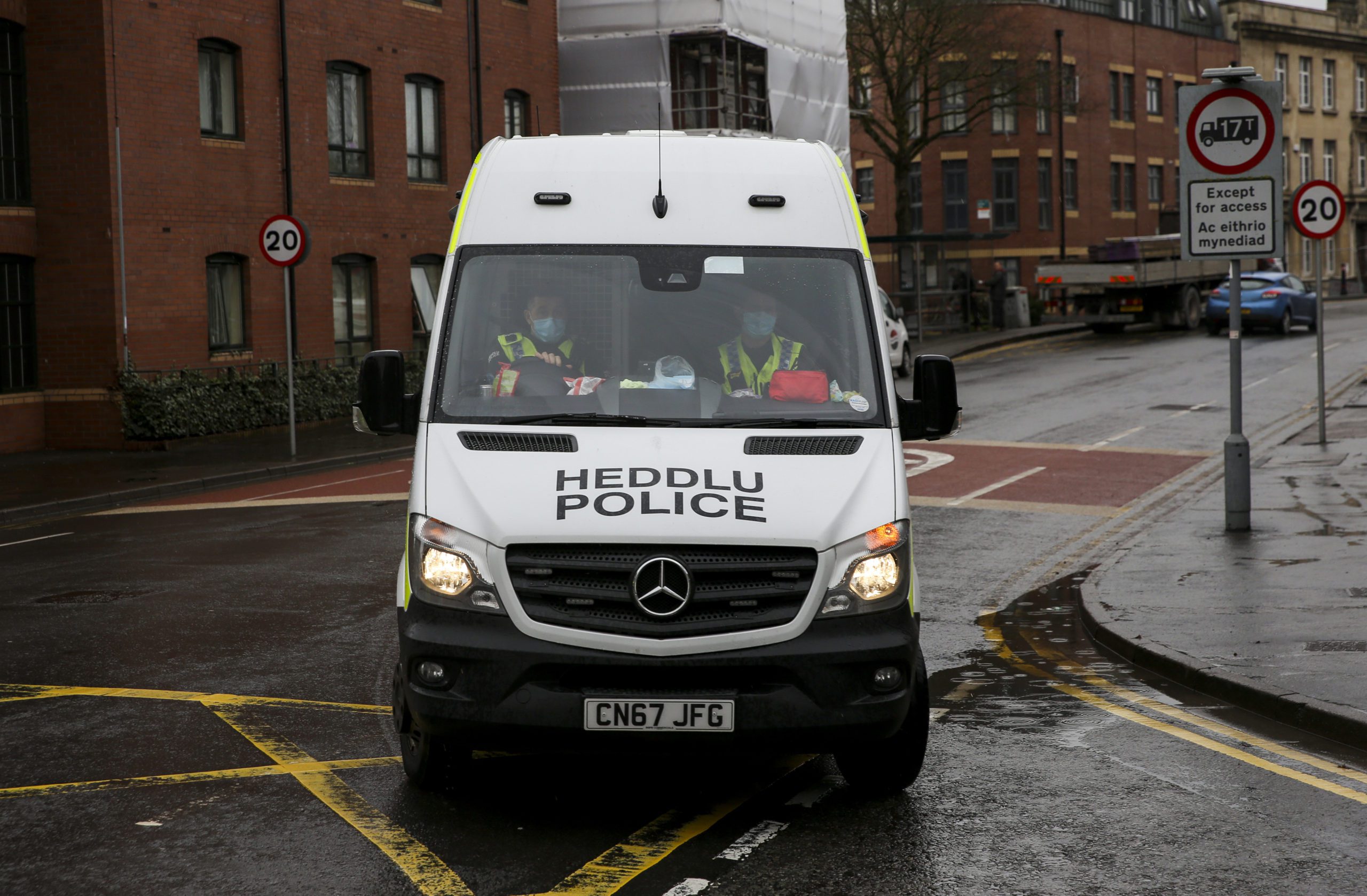
Revealed: The Alarming Rise Of Taser Use Among Welsh Cops
We have looked into the ‘less-lethal’ love affair between the infamous American stun-gun and Welsh police forces. They’re not pleasant findings.
Image by Tom Davies
Welsh police officers wear a weapon on their belt that could reduce even the nation’s toughest rugby players from human giants to shivering wrecks with one quick zap. It is a weapon that is quick to use, easy, always painful, and sometimes deadly.
This weapon has been used in Wales and the whole of the UK since its introduction by the Labour Government in 2003 as a quick and efficient tool for knocking people onto the floor in seconds. But after extensive use in a variety of environments it’s described by the Home Office itself as less-lethal, rather than non-lethal.
The taser has been the centre of a number of controversies revolving around whether the electric shock, delivered through two barbs that enter the skin, can affect the rhythm of the heart. Multiple incidents have resulted in the death of members of the public from sudden cardiac arrest in otherwise healthy people after taking a shock from a Taser gun.
In 2009 a company called Taser International, now rebranded as Axon, issued new guidance to law enforcement using the weapon to aim away from the chest – though UK police haven’t taken much notice.
Axon has taken the incredible profits made from sales of the taser to develop many more products and services to cops around the globe. Cardiff police record their arrests on Axon body-worn video, which then is uploaded to an Axon cloud-storage service, evidence.com.
The use of tasers in Wales has often been controversial. This is a breakdown of the four Welsh police forces and their scandals involving the sometimes-deadly weapon.
SOUTH WALES POLICE
Mohamud Hassan, 29, and Leighton Jones, 30, died this year after contact with South Wales Police.
The families have suggested that tasers might have been used on both men during their restraint but the IOPC, still investigating both deaths, has denied this after saying they’ve reviewed the initial evidence.
But there’s good reason for the families to suspect a taser was involved just by looking at past incidents involving SWP cops.
Tasers are so routinely used by officers that they were deployed in 142 incidents, ranging from drawing the weapon to threaten the subject to actually firing on the target, across SWP territory in just three months between April and June 2021.
SWP cops also drew the weapon on 58 children between 2018-2019, including some under 11 years-old, and more recently fired on a pregnant woman.
In Summer 2020, a member of the public was tased by an officer in Barry during an altercation that was caught on a bystander’s mobile phone. The shocking footage showed the cop firing his taser, causing the woman to fall onto her stomach after the barbs gave her an electric shock.
Leanne Perrett, 35, miscarried just days later, when she was three-months into her pregnancy. A spokesperson for the force told press: “The Taser footage was reviewed by South Wales police with no issues identified.”
GWENT POLICE
A top cop of Gwent Police, chief constable Pam Kelly, told press in August 2019 of their ambition to roll out tasers more widely: “20% of the overall staff will have a taser – they are good deterrents if people have a weapon.”
As the force has started to become more comfortable using tasers, the investment into the stun guns has also risen. Recently Gwent Police were given £66,000 by the UK Home Office to buy 80 more weapons.
In the latest year of stats available, April 2019 to March 2020, Gwent officers deployed a taser on 114 occasions against members of the public. Figures from 2018/19 had more than doubled from the year before.
Contrast the above figure with Gwent Police deploying the taser just 13 times in 16 months back in 2007/08. The difference serves as damning evidence of how much more widespread the use has become across the force, especially concerning when their targets have included young teens as early as 2013.
The study, by OpenWorld News, revealed that a 14-year-old suspected of burglary and holding a screwdriver was stunned with 50,000 volts by Gwent Police officers in 2012.
The increase around that time might be due to a change in rules. According to a police watchdog report use of the taser was “authorised in a much wider range of situations [in 2007]… and extended to a larger number of police officers.”
The risks of misfiring were highlighted in 2009 when a Gwent cop accidentally fired a taser barb into his finger whilst checking to see if it was working, shortly after the rollout.
NORTH WALES POLICE
Ex-Police and Crime Commissioner Arfon Jones had unusually progressive views on drug prohibition for someone in his position, often earning him recognition for his campaigning.
But less lauded are his views on taser use amongst his officers. Jones used a spate of unfortunate attacks on his North Wales Police officers in 2019 to win public favour for giving more cops the ‘less-lethal’ devices for everyday use.
Carl Foulkes, Chief Constable of North Wales Police, added that he would want the taser to become “PPE (Personal Protective Equipment) for all our staff in the future,” likening the stun gun weapon to anti-spit hoods and handcuffs.
After his campaign, Jones successfully found £137,000 of public money to arm his cops with 167 new Tasers in March 2020. It was found that 79% of North Wales Police would be overjoyed at this.
“Should tasers really be used on children?” said Jones’ successor PCC Andy Dunbobbin about the cops in his new jurisdiction, after finding out that they had used Tasers on children in 2019/20 on more than a dozen occasions.
But time will tell whether Dunbobbin holds himself accountable to the same degree as his predecessor.
DYFED POWYS POLICE
Between April and June 2021, Dyfed Powys officers have moved so far away from more traditional methods of restraint they are almost redundant. During this period cops in the force deployed Tasers 121 times and used truncheons only three times.
We must also consider that introducing a weapon onto the streets, whether in the possession of a police officer or not, risks increasing the chance of violence in general and the weapons being discharged.
In February 2019, a cop stopped two men in a car driving through Ceredigion and reached into the car window whilst talking to the driver, removing the keys from the ignition.
At that point the two men got out of the car and one lunged for the cop’s taser. He then shot the officer in the bicep, leaving him on the floor.
Despite the high rate of taser use in general, Dyfed Powys Police have shown more restraint than all other forces in Wales by not zapping children with their weapons.
Cops did threaten children with electrocution on 13 occasions during 2019/20, but managed to resist the urge to actually shoot them.
THE FUTURE
A worrying 94% of police officers want more frontline staff to have tasers, according to the Police Federation of England and Wales, a figure that helped Priti Patel’s Home Office to sell to the public a £10 million investment in police Tasers in 2019.
Some £575,850 of this investment has been spent on arming Welsh cops with around 700 stun guns in the past couple of years, so we can only prepare to see more people electrocuted on the streets of Wales at cop’s discretion. We know from publicly available figures that tasers are used disproportionately on black people, too
Welsh police are unlikely to give up the use of their tasers any time soon, as just recently a Cardiff cop was caught on film tasering a man waving a machete in Llanrumney.
He had surrendered his weapon and was complying with police orders, having his hands up in the air showing himself unarmed before being stunned and crumpling to the ground doubled-up in pain.
The increasing use of tasers in Welsh policing means that police will use them in an ever wider range of situations, and instead of non violent methods will reach for the less-lethal, rather than non-lethal, device on their belts.

